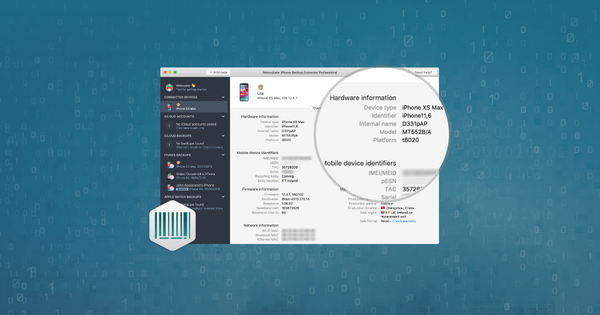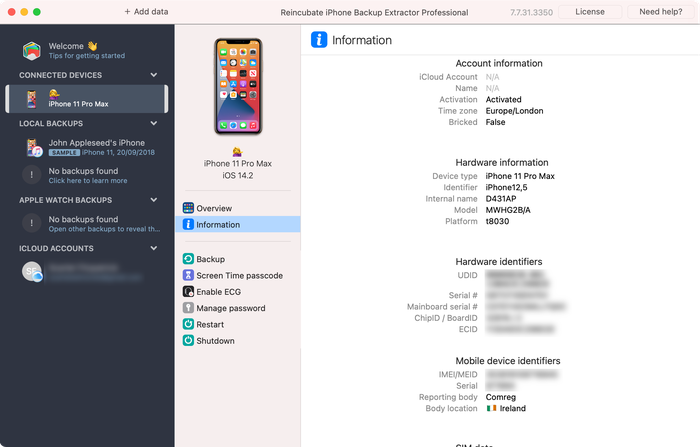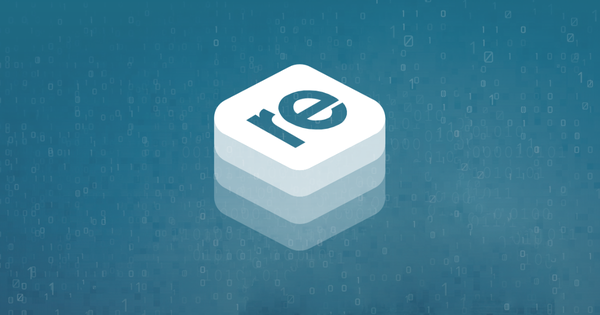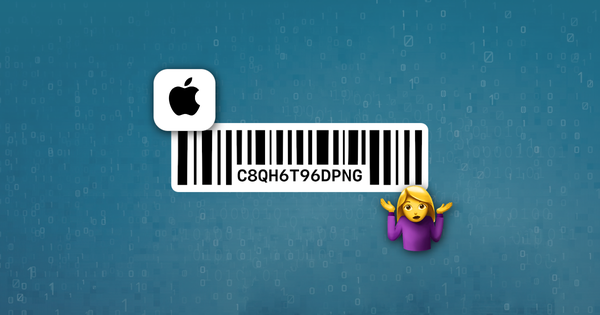Getting detailed mobile data from iOS devices

At Reincubate we set out to help people get better access to their own data, wherever it may be. Today's release of iPhone Backup Extractor introduces a new dimension of data that we're able to help users access. As with almost all of the changes we make, this is rolled in for all users, at no extra cost.

Find your IMEI, device model, ICCID and serial number
We've introduced a new "Info" tab which appears when examining backups of iOS devices. Let's take a short tour through the data we provide, and what it means:
Backup details
- Size. This summarises the total size of the backup.
- File count. Most backups compromise a handful of "meta" files (such as a
Manifestor set ofPlistfiles) along with tens or hundreds of thousands of data files. - Backup type. The backup type shows whether the backup is encrypted, and if so, which encryption format to use.
- Status. Whether the backup is complete or partial.
- Location. The disk or volume that the backup is stored on. By clicking "Reveal in Finder", users are able to jump straight into the backup from their filesystem.
Account information
- iCloud account. If the device is associated with an iCloud account, it'll be shown here.
Hardware information
- Identifier. Apple's identifiers are their core, top-level model identifiers, such as
iPhone10,6. - Serial #. Apple serial numbers come in three different formats, with a fourth due to arrive shortly. They encode and link to a large range of useful information.
- Internal model. Apple's internal model names are sometimes referred to as the
BoardConfig, and they are useful in a number of applications. - UDID. Apple's UDID used to be used as the primary unique identifier for iPhones. This changed after iOS 5 when they were deprecated in favour of IDA and IDFV values, but they are still useful in some cases.
Mobile device identifiers
- IMEI / MEID. The IMEI and MEID are the core global standards for identifying mobile devices.
- pESN. The pseudo-ESN is a legacy identifier for mobile devices, still occasionally used in the US.
- TAC. A device's type allocation code is a gateway to a host of information about a manufactured class of device.
- Serial. Each IMEI or MEID has an identifying serial number, and this is it.
- Reporting body. The reporting body is the organisation responsible for registering that mobile device. Every mobile device must be registered with an agency like this.
- Body location. This shows where your device's reporting body is based in the world. It's not necessarily the country you're in, it may not necessarily operate under the same data protection law that you do.
Manufacturing details
- Production date. This is the date -- usually accurate to a week -- that one of Apple's production partners manufactured your device.
- Production number. A large number of devices are manufactured each week, and this is how far along yours was.
- Production partner. Apple subcontracts manufacturing of devices out to partners all over the world. Whilst Foxconn are in the news a lot, they are only one of many partners. This is the partner that made yours.
- Production location. Most production partners have a number of different factories and production plants. This will tell you the country and city your device was produced in.
- Sale region. Devices are configured differently for different regions when they're made, usually to comply with variations in local law. This field shows where you device was made.
- Sale format. The sale format identifies whether your device was sold at retail, refurbished, or personalised.
- Check warranty. This link takes you to Apple's Service and Coverage site, where you'll be able to check the remaining warranty of your device.
SIM provider data
- ICCID. The
ICCIDis your SIM's unique identifier. That's the little card that goes in your phone from the phone company. Some devices have integrated SIMs, or e-SIMs, such as some models of iPad and Apple Watch. - SIM number. Each SIM has a serial. There are many like it, but this one is yours.
- SIM country. This is where the SIM's provider is registered. Generally, the country your mobile provider is based in. Often these companies are multinational.
- SIM provider. This is the registered provider of your SIM card. Many mobile providers are "virtual" which may mean the people managing your mobile identity aren't who or where you think they are.
- SIM creation date. This is the date your SIM card was issued.
How does it work, and is it secure?
In order to be able to provide this data on your devices, we had to invest in building a large dataset that enables us to look up all sorts of attributes from iOS and mobile devices. From details on Apple serial numbers, device production plans, mysterious "type allocation codes" and "regional body identifiers", we've had to build a large set of support data.
Firstly -- and most importantly -- we don't store your identifying device data. We don't retain anyone's data. In fact, we don't even analyse your device data directly: we built functionality to anonymise the assorted data points, so that we can anonymise them before we look up extended information to display in iPhone Backup Extractor.
We feel it's important to show how the technology works, and to that end we've opened up the API we built to do this, so that anyone can use it. The DeviceIdentifier API is free to use casually by all users, and we have a sign-up available for users who need to use it at scale. Just as we did for our iCloud API, we've open sourced client libraries for DeviceIdentifiers, so that users can easily integrate with it in Python or C#.
Our API can actually do quite a bit more than iPhone Backup Extractor is currently doing with it. Aside from a number of other types of data, it's capable of interfacing with Apple's GSX API to provide data on sale, warranty, carrier and iCloud activation locks. Users need pre-existing GSX access rights in order to take advantage of this.
We're grateful to our beta testers and early customers of the DeviceIdentifier API. Thank you! ❤️
As ever, it's great to receive feedback from customers and users on how we're doing. Please don't be a stranger, drop us a note or live chat message with your thoughts. ✍️




